| |
|
It is always
interesting when you find a parish church remote
from its village, as you often do in Suffolk.
More than once I've read accounts in church
guides blaming the Black Death for depopulating
the village and the villagers starting again
elsewhere, though there's no evidence to suggest
this was the cause of the isolation of any
Suffolk churches. But the removal of the village
of Bildeston from its parish church is fairly
well-documented and researched. Here, beside the
church, are traces of a substantial manor house.
Until 1960s hedge-removal and deep-ploughing
destroyed them, there was also evidence of other
dwellings, smallholdings, farmsteads and
tenements.
They were much older than the church, but, of
course, this church was built on the site of its
predecessor, located for the convenience of the
manor house. So, why are there no houses here
now? Some time in the 13th century, people from
this parish migrated down to the river valley,
possibly to be near resources for the budding
cloth industry. Soon, this new community was
active enough to merit a market, and here, on the
main road between Stowmarket and Hadleigh, it
became a busy one. Changing patterns of
agriculture in the late medieval period meant the
disappearance of the remaining community from
around the church, and so now St Mary Magdalene
stands grand, isolated, and half a mile or so
from the large village (almost a small town) of
Bildeston. This, conversely, makes Bildeston a
rather curious village, since it has a market
place, but there isn't a church on it.
At one time St Mary Magdalene stood rather more
grandly than it does now. On the morning of May
8th 1975 however, the villagers were startled by
a tremendous roar. It was the sound of the tower
of their church collapsing. Tower collapses were
common enough in 18th century Suffolk, as two
centuries of post-Reformation neglect took their
toll. But the Victorian restorers had largely
done away with this problem (although the
unrestored tower at Stanton All Saints had
collapsed as recently as 1906).
Here at Bildeston, ironically, the tower was
undergoing radical surgery at the time, and the
medieval bells had already been removed. The
photograph inside the church of the morning after
the collapse shows the rubble interlaced with
scaffolding, which has splintered like so many
matchsticks. Until a couple of years ago the
remains of the tower still lay in the graveyard,
a heap of flint and freestone to the north of the
new tower, but they have now been removed to be
reused in the construction of a barn and some
nearby holiday homes. The replacement tower is
topped by a bare, functional box with a perky
spire. It may well have been intended as a
temporary arrangement in the 1980s, but it is
hard to see how it will ever be replaced now.
It does to its credit accentuate the height of
the nave and chancel, the pretty clerestory of
which is picked out in flint and brick. This is a
typically grand Suffolk church, like near
neighbours Hitcham and Rattlesden. The sloping
churchyard is neat and trim, with large trees
surrounding it. The whole piece rides the fields
like a ship in a storm. The south porch is also
typical of late medieval Suffolk, its grand
flushwork a testimony to 15th century piety and
Marian devotion. The doorway must be among the
most impressive in the county of its period and
has echoes a few miles off at Hitcham and Thorpe
Morieux.
This was the corner that the fall of the tower
took out, and as part of the repair a typically
excellent window by Pippa Blackall of St Mary
Magdalene and St Mary Salome at the empty tomb
was installed at the west end of the south aisle.
St Gabriel rises magnificently above them. 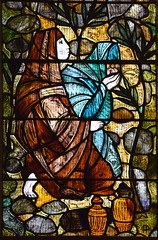 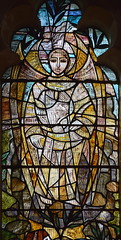
The size of the
interior is accentuated by the lack of a chancel
arch, and triumphant arcades march eastwards in a
manner reminiscent of their near contemporaries
at Lavenham. The capitals depict circles of tiny
angels, all of them slightly different. The south
aisle is now rededicated as the chapel of St
Nicholas, and retains the sanctuary furnishings
of Wattisham parish church, declared redundant by
the diocese in the 1970s. The dado of the
roodscreen, with restored saints, forms two parts
a reredos separated by a beautifully lettered
stone. Memorials removed from Wattisham church,
including the war memorial, are also here, which
seems a pity when they were part of the history
of their former building. Such removals were
unusual, but presumably happened in this case
because it was thought demolition of Wattisham
church was a likely possibility. Thankfully, it
still stands.
The most striking feature of the south aisle, and
of the church as a whole, is a large 1890s window
by Kempe & Co. I must say that I am not a fan
of the workshop, but this is very good of its
kind, depicting as it does small vignettes rather
than large subjects. The main subject is the
Annunciation, but also shown are the Visitation,
the angel appearing to Zechariah in the temple,
and the angel appearing to the shepherds in the
hills above Bethlehem.
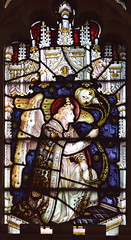 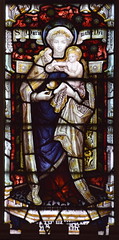 
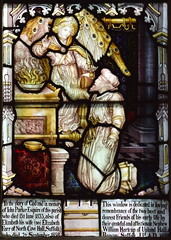 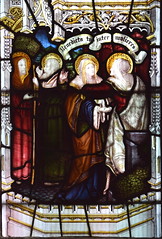 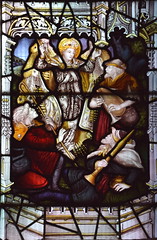
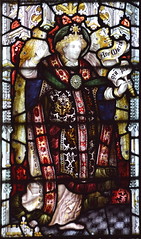 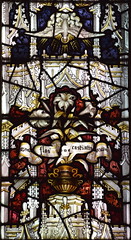 
The clerestory
continues right up to the east end of the
chancel. Looking westwards from here, the high
clerestory and the repairs after the tower's
collapse seem severe, almost austere, the tiny
sanctus bell window punctuating the vast wall.
The large 15th Century clunch font is quite lost
in the space below it, and is in any case rather
battered, but worth a look because one of the
wodewoses around the stem is holding a sword and
a shield.
A tremendous amount of careful restoration has
gone into this building over the last quarter of
a century, and it is not surprising that it has
lost the patina of age. However, another survival
from the past can be seen up in the chancel. The
stalls, with battered misericords, were, Mortlock
says, removed from the now-vanished chapel of
ease of St Leonard down in the village. A
survival that might have been, but wasn't, is the
roodscreen. Without a chancel arch, it must have
been enormous. It survived the Reformation, it
survived the Puritans, only to be destroyed in an
18th century reordering.
|
|
|

